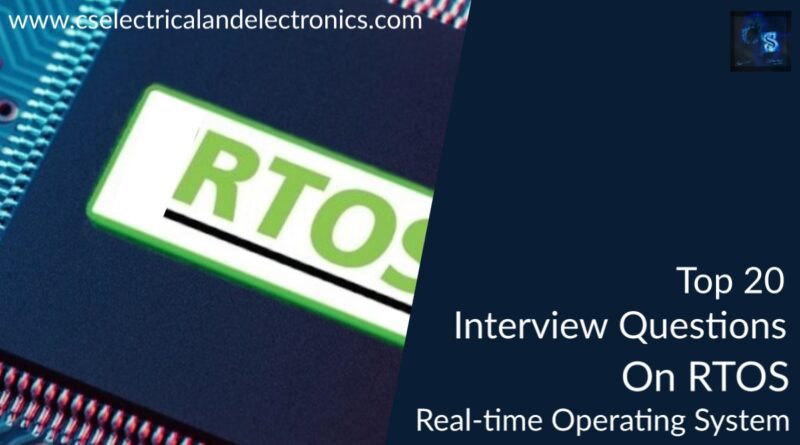Top 20 Interview Questions On RTOS, Real-Time Operating System
Hello guys, welcome back to our blog. Here in this article, we will discuss the top 20 interview questions on RTOS (Real Time Operating System), and the questions added below are the most commonly asked interview questions.
If you have any electrical, electronics, and computer science doubts, then ask questions. You can also catch me on Instagram – CS Electrical & Electronics.
Also, read:
- Top 20 Digital Marketing Interview Questions With Answers
- Top 20 Interview Questions On IoT, Internet Of Things
- Top 22 MATLAB Simulink Interview Questions And Answers
Interview Questions On RTOS
A real-time operating system (RTOS) is a type of operating system that is designed to meet the requirements of real-time applications, which require quick and predictable responses to events. RTOSes are used in a variety of applications, including avionics, industrial automation, medical devices, and embedded systems.
An RTOS typically includes a real-time kernel, which is responsible for managing tasks, scheduling, and synchronization, as well as a set of system services that are used by tasks and interrupt service routines. RTOSes also often include support for real-time communication, such as message queues and semaphores, and may include support for real-time clocks, timers, and other hardware components.
One key feature of an RTOS is its ability to prioritize tasks based on the needs of the application. This allows high-priority tasks to be executed in a timely manner, even if lower-priority tasks are also running. RTOSes also often include mechanisms to prevent or recover from errors or failures, such as watchdog timers and fault-tolerant architectures. let’s discuss some interview questions on RTOS.
01. What is an RTOS?
Ans. An RTOS (Real-Time Operating System) is a type of operating system that is designed to meet the requirements of real-time applications, which require quick and predictable responses to events.
02. What is a task in an RTOS?
Ans. A task in an RTOS is a program or function that is executed by the operating system. Tasks can be periodic or aperiodic, and they can be prioritized based on the needs of the application.
03. What is a semaphore in an RTOS?
Ans. A semaphore is a synchronization object that is used to control access to shared resources in an RTOS. Semaphores can be binary (0 or 1) or counting (integer values greater than 0).
04. What is a mutex in an RTOS?
Ans. A mutex (short for “mutual exclusion”) is a synchronization object that is used to protect shared resources from being accessed simultaneously by multiple tasks. Mutexes can be used to implement critical sections in an RTOS.
05. What is a message queue in an RTOS?
Ans. A message queue is a data structure that is used to store messages that are exchanged between tasks or between tasks and interrupt service routines in an RTOS.
06. What is a timer in an RTOS?
Ans. A timer in an RTOS is a hardware or software component that is used to generate periodic or one-shot events. Timers can be used to trigger tasks or interrupt service routines at specific intervals.
07. What is a priority inversion in an RTOS?
Ans. Priority inversion is a situation in which a low-priority task holds a resource that a high-priority task needs, causing the high-priority task to be blocked and unable to run. This can lead to unpredictable and unacceptable delays in real-time systems.
08. What is preemption in an RTOS?
Ans. Preemption is the process of interrupting the execution of a task and temporarily suspending it to allow another task with a higher priority to run. Preemption is used to ensure that high-priority tasks are able to run in a timely manner.
09. What is a scheduler in an RTOS?
Ans. A scheduler is a component of an RTOS that is responsible for deciding which task to run next. Schedulers use various algorithms to determine the order in which tasks are executed.
10. What is a context switch in an RTOS?
Ans. A context switch is a process of saving the current state of a task and restoring the state of a different task. Context switches occur when the scheduler selects a different task to run.
11. What is a deadlock in an RTOS?
Ans. A deadlock is a situation in which two or more tasks are blocked and unable to proceed because each task is waiting for a resource held by one of the other tasks. Deadlocks can occur in RTOS if proper synchronization is not implemented.
12. What is a watchdog timer in an RTOS?
Ans. A watchdog timer is a hardware or software component that is used to detect and recover from failures in an RTOS. The watchdog timer is typically configured to reset the system if a task or interrupt service routine does not completed within a specified time period.
13. What is a hybrid RTOS?
Ans. A hybrid RTOS is an operating system that combines the features of a traditional RTOS with those of a general-purpose operating system (GPOS). Hybrid RTOSes are designed to provide the real-time capabilities of an RTOS with the flexibility and scalability of a GPOS.
14. What is an event in an RTOS?
Ans. An event in an RTOS is a condition that is detected by a task or interrupts a service routine and that may trigger the execution of another task or interrupt a service routine. Events can be used to synchronize the execution of tasks or to communicate between tasks.
15. What is a hook function in an RTOS?
Ans. A hook function in an RTOS is a user-defined function that is called by the operating system at certain points in the execution of a task or interrupt service routine. Hook functions can be used to customize the behavior of the operating system or to perform specific actions at certain points in the execution of a task.
16. What is an interrupt in an RTOS?
Ans. An interrupt in an RTOS is a signal that is generated by a hardware or software component to indicate that an event has occurred. Interrupts can be used to trigger the execution of an interrupt service routine, which can perform specific actions in response to the interrupt.
17. What is an interrupt service routine in an RTOS?
Ans. An interrupt service routine (ISR) is a function that is executed in response to an interrupt. ISRs are typically used to handle events that require immediate attention, such as input/output operations or data communication.
18. What is a task control block in an RTOS?
Ans. A task control block (TCB) is a data structure that is used to store information about a task in an RTOS. TCBs typically include information such as the task’s priority, stack pointer, and status.
19. What is a real-time clock in an RTOS?
Ans. A real-time clock (RTC) is a hardware component that is used to maintain the current time and date in an RTOS. RTCs can be used to trigger tasks or interrupt service routines at specific times or intervals.
20. What is a real-time kernel in an RTOS?
Ans. A real-time kernel is the central component of an RTOS that is responsible for managing tasks, scheduling, and synchronization. The real-time kernel typically includes a scheduler, a set of synchronization objects, and a set of system services that are used by tasks and interrupt service routines.
These are the very important interview questions on RTOS.
Why RTOS is a very important subject for embedded engineers
Real-time operating systems (RTOSes) are an important subject for embedded engineers because they are used to build systems that require quick and predictable responses to events. RTOSes are used in a variety of embedded applications, including avionics, industrial automation, medical devices, and automotive systems.
In these types of systems, it is often critical to meet real-time requirements, such as deadlines for processing data or responding to external events. RTOSes provide tools and mechanisms to manage tasks, schedule execution and synchronize access to shared resources, which are essential for building reliable and efficient embedded systems.
RTOSes also provide support for a range of hardware components and peripherals that are commonly used in embedded systems, such as real-time clocks, timers, and communication interfaces.
Overall, RTOSes are an important subject for embedded engineers because they provide the foundation for building reliable and efficient embedded systems that meet the demands of real-time applications.
This was about “Interview Questions On RTOS“. I hope this article may help you all a lot. Thank you for reading.
Also, read:
- 100 + Electrical Engineering Projects For Students, Engineers
- 1000+ Electronics Projects For Engineers, Diploma, MTech Students
- 1000+ MATLAB Simulink Projects For MTech, Engineering Students
- 500+ Embedded System Projects For Engineer, Diploma, MTech, PhD
- 500+ Projects For Diploma Electrical, Electronics Student, Diploma Project
- 8051 Microcontroller Timers, TCON Register, TMOD Register
- Advancements In 3D Printing Technology And It’s Future
- Advancements In Power Electronics For Energy Efficiency
Author Profile
- Chetu
- Interest's ~ Engineering | Entrepreneurship | Politics | History | Travelling | Content Writing | Technology | Cooking
Latest entries
 All PostsApril 19, 2024What Is Vector CANoe Tool, Why It Is Used In The Automotive Industry
All PostsApril 19, 2024What Is Vector CANoe Tool, Why It Is Used In The Automotive Industry All PostsApril 13, 2024What Is TCM, Transmission Control Module, Working, Purpose,
All PostsApril 13, 2024What Is TCM, Transmission Control Module, Working, Purpose, All PostsApril 12, 2024Top 100 HiL hardware in loop Interview Questions With Answers For Engineers
All PostsApril 12, 2024Top 100 HiL hardware in loop Interview Questions With Answers For Engineers All PostsMarch 22, 2024Driver Monitoring Systems In Vehicles, Working, Driver Sleepy Alert
All PostsMarch 22, 2024Driver Monitoring Systems In Vehicles, Working, Driver Sleepy Alert








